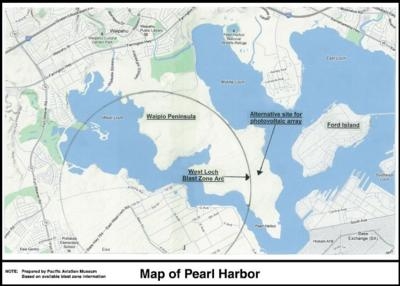Would Cover The Historic Runway At Pearl Harbor With Photo-Electric Generating Cells
Ford Island, in the heart of Pearl Harbor, is a site that many have likened to Gettysburg, Valley Forge, and the Alamo. The 4,000 foot runway, part of Naval Air Station Ford Island from 1921 to 1961, has been part of the Pearl Harbor National Historic Landmark since 1964 and on the National Register of Historic Places since 1976.

The U.S. Navy is now proposing to cover the runway and 14 acres of adjoining land (a total of 28 acres) with 60,000 photovoltaic panels in a move that will convert the nature and appearance of this hallowed ground to an industrial project. In addition to the panels, the project will require numerous “inverter stations” between the former runway and ramp area and the entire photovoltaic panel area will be surrounded by a black chain-link fence.
The above image prepared by the Navy provides a reasonable depiction of the likely appearance. Two of the three Pacific Aviation Museum (PAM) hangars can be seen to the left; the recently restored Ford Island Control Tower is further to the left of the two hangars.
On December 7, 2006, PAM opened in the first of three hangars which survived the attack on Pearl Harbor. To date the museum has welcomed more than 800,000 visitors. The museum’s mission is to educate young and old alike, honor aviators and their support personnel who defended freedom in the Pacific region, and preserve Pacific region aviation artifacts. The museum feels that the Ford Island runway, which played a key role in WWII, is one such artifact.

At its meeting on July 19, 2012, PAM’s Board of Directors voted unanimously to oppose the Navy’s plans to cover the runway and adjoining land with photovoltaic cells. This decision was not taken lightly in view of the fact that the U.S. Navy is PAM’s landlord. In communicating its position to the Navy, the museum stated “the size and prominence of this project would violate this hallowed ground….while we are in total support of developing renewable energy sources and making “green power” available, we encourage the Navy to find another location for such a project that does not have a negative impact on the rich history of the current proposed site.” The museum has encouraged the Navy to relocate the project to a far larger tract of Navy land at Waipio Peninsula (pictured).
The 2007 National Defense Authorization Act requires the U.S. Navy to obtain 25% of its electric power from renewable sources by 2025. After receiving 13 responses to undertake $500 million worth of solar power systems in Hawaii, three companies were selected (Photon Finance LLC, Island Pacific Energy LLC, and Pacific Energy Solutions LLC). The Navy is in the process of issuing “task orders” to design, construct, own, operate, and maintain the solar power systems; Task Order #2 is apparently in process for Ford Island. No public hearing has been held nor, apparently, is any contemplated before construction commences.
PAM is currently the lone voice in opposition to this initiative. This project is not at all in keeping with the significance of the historic Pearl Harbor battlefield. "We ask the reader to consider the hue and cry should a 60,000 panel photovoltaic project be located at Gettysburg or Valley Forge," museum officials said.
 ANN's Daily Aero-Linx (05.02.24)
ANN's Daily Aero-Linx (05.02.24) ANN's Daily Aero-Term (05.02.24): Touchdown Zone Lighting
ANN's Daily Aero-Term (05.02.24): Touchdown Zone Lighting Aero-News: Quote of the Day (05.02.24)
Aero-News: Quote of the Day (05.02.24) ANN FAQ: Contributing To Aero-TV
ANN FAQ: Contributing To Aero-TV NTSB Final Report: Cirrus Design Corp SR20
NTSB Final Report: Cirrus Design Corp SR20




